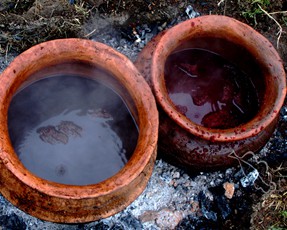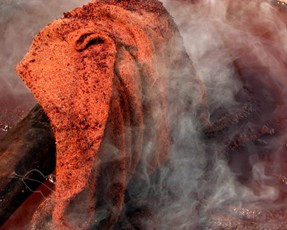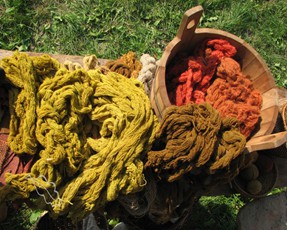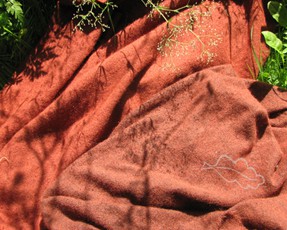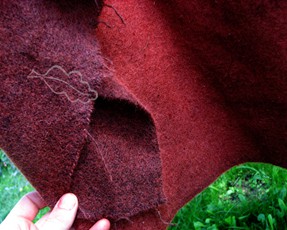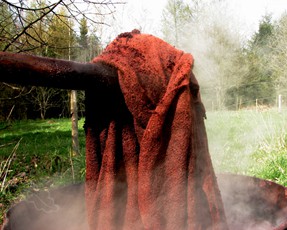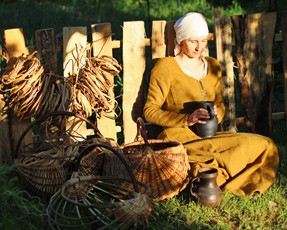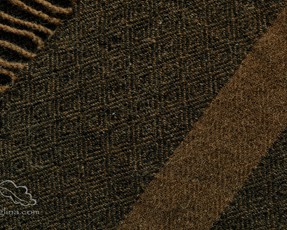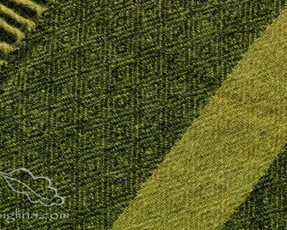
In the Middle Ages, before the weavers’ and dyers’ guilds were established and before the times of far-reaching trade, families and communities were self-sufficient. The weaving and dyeing was done at home, using plants cultivated in gardens or local fauna and flora. The color however was one of the telltale signs of social status. Bright, strong hues resulted not only from using the right dyes, but also from the kind of fabric – usually wool. Rich colors were not only a sign of material wealth, but also of the social standing of the wearer in the local community. It emphasized their status and trade and had symbolical and magical meaning. A wealthy merchant wore different clothes than a fisherman. Natural hues of woolen fabric – shades of grey and brown – were a telltale sign that the wearer plies a common trade, rather than being someone from upper social classes.
The most popular dyeing plants in Europe, known from archeological and historical sources, are arguably MADDER and WOAD. They were grown on a large scale and widely traded in Middle Ages. Also popular were safflower (carthamus tinctoris), dyer’s broom (gensita tinctoria) and weld (reseda luteola). They dyed various shades of yellow and also red (safflower). One product that was known in the antique world and mentioned in early Middle Ages as a strong dye were the walnut husks (juglans regia). They were transported via the river Rhein north, where they didn’t grow at that time.
Apart from grown dyes, medieval dyers used also local, wild-growing plants, fungi and lichens, and also insects. A widely known dye were the larvae of a local (Poland, Lithuania, parts of Germany) insect called Polish cochineal (Polish carmine scale) (porphyrophora polonica v. cocus polonicus) that produced a beautiful, rich scarlet. It was exported since the early Middle Ages to many West European countries. Another scale insect producing beautiful shades of scarlet was so called kermes (kermes vermillio), imported to the cities of northern Europe from the Mediterranean. The use of both these insects were gradually abandoned with introduction of imported cochineal. Few centuries earlier no less important dye was tyrian purple, in the times of the Roman Empire produced from sea snails (murex trunculus, murex brandaris). It was the most expensive dye of the Antiquity.
Madder (rubia tinctoria), one of the most important medieval dyes, used since antique times, grows naturally in southern Europe and in Asia Minor. Its roots produce various shads of red and purples. It was widely grown in Germany (until the 19th century and the introduction of synthetic dyes), exported to many countries, Poland among them.
Woad (isatis tinctoria) produces shades of blue and green and is a plant of south-eastern European origin. Its traces are found in archeological sites as early as the Stone Age. In the Middle Ages it was cultivated mostly in Germany and exported to other countries. The dye itself – indigotin – was extracted during a long, complex process of fermentation. In the Middle Ages selling the semi-finished dye products yielded significant income and as such was closely guarded: using the forbidden “indigo”, an extract from the Indian true indigo (indigofera tinctoria), was at first punished with death. The true indigo was imported to Europe by sea; despite bans and restrictions ultimately it made woad obsolete and forgotten.
IMPORTED DYES: partly already known in the Middle Ages, widely used in the modern era until the discovery of synthetic dyes.
· Indigo – an extract from the Chinese/Japanese indigo (polygonum tinctorium)
· Cochineal (cocus cacti) – an animal dye, producing shades of red, imported from Central America and Mexico
· Brasilwood (caesalpina braziliens) – Asia, South America
· Logwood (haematoxylon campechianum) – also called campeche, Central America
· Dyer’s mulberry (morus tinctoria) – also called gelbholtz, grows in South America
· Black oak (quercus tinctoria) – yellow, brown, South America
· Smoketree (rhus cotinus) – yellow, North America, Asia
· Curcuma (curcuma longa) – yellow, Asia
· Saffron crocus (crocus dativus) – yellow, Asia
Alfred Leix writes in “Dyeing and Dyers’ Guilds in Mediaeval Craftsmanship” that the establishing of the dyers’ guilds led also to establishing dyers’ specialization. He names three groups: the first and most numerous one are “black”, common dyers, dyeing fabrics to all shades and hues. Black dyers learned their craft during a three-year long apprentice’s journey, and they wore distinctive blue scarves. The next group are dyers handling expensive, good quality fabrics. They were few in number and operated outside of the guild system. The last, least numerous group are dyers of silk. Because of the nature of their trade they appeared in southern Europe and also operated outside of guilds, more akin to independent artists than craftsmen.
Ordering & Information:
Joanna "Heidi" Hajduk-Dziewientkowska i Krzysztof "Helfi"
Dziewientkowski
tel. 608-174-654
email: lepiglina.com@gmail.com.
